Activation of Thioglycosides with Copper(II) Bromide
Abstract
1. Introduction
2. Results and Discussion
3. Experimental
3.1. Synthesis of Building Blocks
3.2. Synthesis of Disaccharides
3.2.1. Method A—General Procedure for Glycosidation of Thioglycosides in the Presence of CuBr2
3.2.2. Method B—General Procedure for Glycosidation of Thioglycosides in the Presence of CuBr2 and TfOH
4. Conclusions
Supplementary Materials
Author Contributions
Funding
Conflicts of Interest
Sample Availability
References
- Demchenko, A.V. (Ed.) Handbook of Chemical Glycosylation: Advances in Stereoselectivity and Therapeutic Relevance; Wiley-VCH: Weinheim, Germany, 2008. [Google Scholar]
- Zhu, X.; Schmidt, R.R. New principles for glycoside-bond formation. Angew. Chem. Int. Ed. 2009, 48, 1900–1934. [Google Scholar] [CrossRef] [PubMed]
- Panza, M.; Pistorio, S.G.; Stine, K.J.; Demchenko, A.V. Automated chemical oligosaccharide synthesis: Novel approach to traditional challenges. Chem. Rev. 2018, 118, 8105–8150. [Google Scholar] [CrossRef] [PubMed]
- Kulkarni, S.S.; Gervay-Hague, J. Glycosyl chlorides, bromides and iodides. In Handbook of Chemical Glycosylation; Demchenko, A.V., Ed.; Wiley-VCH: Weinheim, Germany, 2008; pp. 59–93. [Google Scholar]
- Singh, Y.; Geringer, S.; Demchenko, A.V. Synthesis and glycosidation of anomeric halides: Evolution from early studies to modern methods of the 21st century. Chem. Rev. 2022, 122, 11701–11758. [Google Scholar] [CrossRef]
- Zhu, X.; Schmidt, R.R. Glycoside synthesis from 1-oxygen-substituted glycosyl imidates. In Handbook of Chemical Glycosylation; Demchenko, A.V., Ed.; Wiley-VCH: Weinheim, Germany, 2008; pp. 143–185. [Google Scholar]
- Zhong, W.; Boons, G.-J. Glycoside synthesis from 1-sulfur/selenium-substituted derivatives: Thioglycosides in oligosaccharide synthesis. In Handbook of Chemical Glycosylation; Demchenko, A.V., Ed.; Wiley-VCH: Weinheim, Germany, 2008; pp. 261–303. [Google Scholar]
- Fischer, E.; Delbruck, K. Uber Thiophenol-glucoside. Ber. Dtsch. Chem. Ges. 1909, 42, 1476–1482. [Google Scholar] [CrossRef]
- Oscarson, S. Thioglycosides. In Carbohydrates in Chemistry and Biology; Ernst, B., Hart, G.W., Sinay, P., Eds.; Wiley-VCH: Weinheim, Germany; New York, NY, USA, 2000; Volume 1, pp. 93–116. [Google Scholar]
- Codee, J.D.C.; Litjens, R.E.J.N.; van den Bos, L.J.; Overkleeft, H.S.; van der Marel, G.A. Thioglycosides in sequential glycosylation strategies. Chem. Soc. Rev. 2005, 34, 769–782. [Google Scholar] [CrossRef] [PubMed]
- Lian, G.; Zhang, X.; Yu, B. Thioglycosides in Carbohydrate research. Carbohydr. Res. 2015, 403, 13–22. [Google Scholar] [CrossRef] [PubMed]
- Escopy, S.; Demchenko, A.V. Transition-Metal-Mediated Glycosylation with Thioglycosides. Chem. Eur. J. 2022, 28, e202103747. [Google Scholar] [CrossRef] [PubMed]
- Ferrier, R.J.; Hay, R.W.; Vethaviyasar, N. A potentially versatile synthesis of glycosides. Carbohydr. Res. 1973, 27, 55–61. [Google Scholar] [CrossRef]
- Goswami, M.; Ellern, A.; Pohl, N.L. Bismuth(V)-mediated thioglycoside activation. Angew. Chem. Int. Ed. Engl. 2013, 52, 8441–8445. [Google Scholar] [CrossRef]
- Goswami, M.; Ashley, D.C.; Baik, M.H.; Pohl, N.L. Mechanistic Studies of Bismuth(V)-Mediated Thioglycoside Activation Reveal Differential Reactivity of Anomers. J. Org. Chem. 2016, 81, 5949–5962. [Google Scholar] [CrossRef]
- Vibhute, A.M.; Dhaka, A.; Athiyarath, V.; Sureshan, K.M. A versatile glycosylation strategy via Au (III) catalyzed activation of thioglycoside donors. Chem. Sci. 2016, 7, 4259–4263. [Google Scholar] [CrossRef] [PubMed]
- Adhikari, S.; Baryal, K.N.; Zhu, D.; Li, X.; Zhu, J. Gold-catalyzed synthesis of 2-deoxy glycosides using S-but-3-ynyl thioglycoside donors. ACS Catal. 2013, 3, 57–60. [Google Scholar] [CrossRef]
- Escopy, S.; Singh, Y.; Demchenko, A.V. Palladium(II)-assisted activation of thioglycosides. Org. Biomol. Chem. 2021, 19, 2044–2054. [Google Scholar] [CrossRef] [PubMed]
- Dondoni, A.; Marra, A.; Massi, A. Hybrid solution/solid-phase synthesis of oligosaccharides by using trichloroacetyl isocyanate as sequestration-enabling reagent of sugar alcohols. Angew. Chem. Int. Ed. 2005, 44, 1672–1676. [Google Scholar] [CrossRef]
- Pornsuriyasak, P.; Kamat, M.N.; Demchenko, A.V. Glycosyl thioimidates as versatile glycosyl donors for stereoselective glycosylation and convergent oligosaccharide synthesis. ACS Symp. Ser. 2007, 960, 165–189. [Google Scholar]
- Szeja, W.; Grynkiewicz, G. Xanthates, thioimidates and other thio derivatives. In Handbook of Chemical Glycosylation; Demchenko, A.V., Ed.; Wiley-VCH: Weinhein, Germany, 2008; pp. 329–361. [Google Scholar]
- Hasty, S.J.; Demchenko, A.V. Glycosyl thioimidates as versatile building blocks for organic synthesis. Chem. Heterocycl. Compd. 2012, 48, 220–240. [Google Scholar] [CrossRef]
- Grube, M.; Lee, B.-Y.; Garg, M.; Michel, D.; Vilotijević, I.; Malik, A.; Seeberger, P.H.; Varón Silva, D. Synthesis of Galactosylated Glycosylphosphatidylinositol Derivatives from Trypanosoma brucei. Chem. Eur. J. 2018, 24, 3271–3282. [Google Scholar] [CrossRef]
- Premathilake, H.D.; Mydock, L.K.; Demchenko, A.V. Superarming common glycosyl donors by simple 2-O-benzoyl-3,4,6-tri-O-benzyl protection. J. Org. Chem. 2010, 75, 1095–1100. [Google Scholar] [CrossRef]
- Ranade, S.C.; Kaeothip, S.; Demchenko, A.V. Glycosyl alkoxythioimidates as complementary building blocks for chemical glycosylation. Org. Lett. 2010, 12, 5628–5631. [Google Scholar] [CrossRef]
- Mukaiyama, T.; Takeuchi, K.; Jona, H.; Maeshima, H.; Saitoh, T. A catalytic and stereoselective glycosylation with b-glycosyl fluorides. Helv. Chim. Acta 2000, 83, 1901–1918. [Google Scholar] [CrossRef]
- Goodman, L. Neighboring-group participation in sugars. Adv. Carbohydr. Chem. Biochem. 1967, 22, 109–175. [Google Scholar] [PubMed]
- Dondoni, A.; Marra, A.; Scherrmann, M.-C.; Casnati, A.; Sansone, F.; Ungaro, R. Synthesis and properties of O-glycosyl calix[4]arenes (calixsugars). Chem. Eur. J. 1997, 3, 1774–1782. [Google Scholar] [CrossRef]
- Sail, D.; Kovac, P. Benzoylated ethyl 1-thioglycosides: Direct preparation from per-O-benzoylated sugars. Carbohydr. Res. 2012, 357, 47–52. [Google Scholar] [CrossRef] [PubMed]
- Nigudkar, S.S.; Parameswar, A.R.; Pornsuriyasak, P.; Stine, K.J.; Demchenko, A.V. O-Benzoxazolyl imidates as versatile glycosyl donors for chemical glycosylation. Org. Biomol. Chem. 2013, 11, 4068–4076. [Google Scholar] [CrossRef]
- Bandara, M.D.; Yasomanee, J.P.; Demchenko, A.V. Application of armed, disarmed, superarmed and superdisarmed building blocks in stereocontrolled glycosylation and expeditious oligosaccharide synthesis. In Selective Glycosylations: Synthetic Methods and Catalysts; Bennett, C.S., Ed.; Wiley: Hoboken, NJ, USA, 2017; pp. 29–58. [Google Scholar]
- Grice, P.; Ley, S.V.; Pietruszka, J.; Priepke, H.W.M.; Walther, E.P.E. Tuning the reactivity of glycosides: Efficient one-pot oligosaccharide synthesis. Synlett 1995, 1995, 781–784. [Google Scholar] [CrossRef]
- Douglas, N.L.; Ley, S.V.; Lucking, U.; Warriner, S.L. Tuning glycoside reactivity: New tool for efficient oligosaccharides synthesis. J. Chem. Soc. Perkin Trans. 1 1998, 51–65. [Google Scholar] [CrossRef]
- Zhang, Z.; Ollmann, I.R.; Ye, X.S.; Wischnat, R.; Baasov, T.; Wong, C.H. Programmable one-pot oligosaccharide synthesis. J. Am. Chem. Soc. 1999, 121, 734–753. [Google Scholar] [CrossRef]
- Green, L.G.; Ley, S.V. Protecting groups: Effects on reactivity, glycosylation specificity and coupling efficiency. In Carbohydrates in Chemistry and Biology; Ernst, B., Hart, G.W., Sinay, P., Eds.; Wiley-VCH: Weinheim, Germany; New York, NY, USA, 2000; Volume 1, pp. 427–448. [Google Scholar]
- Fraser-Reid, B.; Lopez, J.C. (Eds.) . Reactivity Tuning in Oligosaccharide Assembly; Springer: Berlin/Heidelberg, Germany, 2011; Volume 301. [Google Scholar]
- Kaeothip, S.; Yasomanee, J.P.; Demchenko, A.V. Glycosidation of thioglycosides in the presence of bromine: Mechanism, reactivity, and stereoselectivity. J. Org. Chem. 2012, 77, 291–299. [Google Scholar] [CrossRef]
- Smith, R.; Muller-Bunz, H.; Zhu, X. Investigation of alpha-Thioglycoside Donors: Reactivity Studies toward Configuration-Controlled Orthogonal Activation in One-Pot Systems. Org. Lett. 2016, 18, 3578–3581. [Google Scholar] [CrossRef]
- Verma, N.; Tu, Z.; Lu, M.S.; Liu, S.H.; Renata, S.; Phang, R.; Liu, P.K.; Ghosh, B.; Lin, C.H. Threshold of Thioglycoside Reactivity Difference Is Critical for Efficient Synthesis of Type I Oligosaccharides by Chemoselective Glycosylation. J. Org. Chem. 2021, 86, 892–916. [Google Scholar] [CrossRef]
- Kihlberg, J.O.; Leigh, D.A.; Bundle, D.R. The in situ activation of thioglycosides with bromine: An improved glycosylation method. J. Org. Chem. 1990, 55, 2860–2863. [Google Scholar] [CrossRef]
- Chatterjee, S.; Moon, S.; Hentschel, F.; Gilmore, K.; Seeberger, P.H. An Empirical Understanding of the Glycosylation Reaction. J. Am. Chem. Soc. 2018, 140, 11942–11953. [Google Scholar] [CrossRef]
- Nguyen, H.M.; Chen, Y.N.; Duron, S.G.; Gin, D.Y. Sulfide-mediated dehydrative glycosylation. J. Am. Chem. Soc. 2001, 123, 8766–8772. [Google Scholar] [CrossRef] [PubMed]
- Kasbeck, L.; Kessler, H. Convenient Syntheses of 2,3,4,6-Tetra-O-alkylated D-Glucose and D-Galactose. Liebigs Ann./Recl. 1997, 1997, 169–173. [Google Scholar] [CrossRef]
- Heuckendorff, M.; Poulsen, L.T.; Jensen, H.H. Remote Electronic Effects by Ether Protecting Groups Fine-Tune Glycosyl Donor Reactivity. J. Org. Chem. 2016, 81, 4988–5006. [Google Scholar] [CrossRef] [PubMed]
- Kaeothip, S.; Demchenko, A.V. On orthogonal and selective activation of glycosyl thioimidates and thioglycosides: Application to oligosaccharide assembly. J. Org. Chem. 2011, 76, 7388–7398. [Google Scholar] [CrossRef] [PubMed]
- Liu, L.; Bytheway, I.; Karoli, T.; Fairweather, J.K.; Cochran, S.; Li, C.; Ferro, V. Design, synthesis, FGF-1 binding, and molecular modeling studies of conformationally flexible heparin mimetic disaccharides. Bioorg. Med. Chem. Lett. 2008, 18, 344–349. [Google Scholar] [CrossRef] [PubMed]
- Li, Z.; Zhu, L.; Kalikanda, J. Development of a highly α-selective galactopyranosyl donor based on a rational design. Tetrahedron Lett. 2011, 52, 5629–5632. [Google Scholar] [CrossRef]
- Shadrick, M.; Singh, Y.; Demchenko, A.V. Stereocontrolled α-galactosylation under cooperative catalysis. J. Org. Chem. 2020, 85, 15936–15944. [Google Scholar] [CrossRef]
- Andersson, F.; Fugedi, P.; Garegg, P.J.; Nashed, M. Synthesis of 1,2-cis-linked glycosides using dimethyl(methylthio)sulfonium triflate as promoter and thioglycosides as glycosyl donors. Tetrahedron Lett. 1986, 27, 3919–3922. [Google Scholar] [CrossRef]
- Veleti, S.K.; Lindenberger, J.J.; Thanna, S.; Ronning, D.R.; Sucheck, S.J. Synthesis of a Poly-hydroxypyrolidine-Based inhibitor of Mycobacterium tuberculosis GlgE. J. Org. Chem. 2014, 79, 9444–9450. [Google Scholar] [CrossRef] [PubMed]
- France, R.R.; Rees, N.V.; Wadhawman, J.D.; Fairbanks, A.J.; Compton, R.G. Selective activation of glycosyl donors using electrochemical techniques: A study of the thermodynamic oxidation potentials of a range of chalcoglycosides. Org. Biomol. Chem. 2004, 2, 2188–2194. [Google Scholar] [CrossRef] [PubMed]
- Houdier, S.; Vottero, P.J.A. Synthesis of benzylated cycloisomaltotri- and hexaosides. Angew. Chem. Int. Ed. Engl. 1994, 33, 354–356. [Google Scholar] [CrossRef]
- Shaw, M.; Thakur, R.; Kumar, A. Gold(III)-Catalyzed Glycosylation using Phenylpropiolate Glycosides: Phenylpropiolic Acid, An Easily Separable and Reusable Leaving Group. J. Org. Chem. 2019, 84, 589–605. [Google Scholar] [CrossRef]
- Garcia, B.A.; Gin, D.Y. Dehydrative glycosylation with activated diphenyl sulfonium reagents. Scope, mode of C(1)-hemiacetal activation, and detection of reactive glycosyl intermediates. J. Am. Chem. Soc. 2000, 122, 4269–4279. [Google Scholar] [CrossRef]
- Fraser-Reid, B.; Wu, Z.; Andrews, C.W.; Skowronski, E. Torsional effects in glycoside reactivity: Saccharide couplings mediated by acetal protecting groups. J. Am. Chem. Soc. 1991, 113, 1434–1435. [Google Scholar] [CrossRef]
- Jensen, H.H.; Nordstrom, L.U.; Bols, M. The disarming effect of the 4,6-acetal group on glycoside reactivity: Torsional or electronic? J. Am. Chem. Soc. 2004, 126, 9205–9213. [Google Scholar] [CrossRef]
- Ma, X.; Zheng, Z.; Fu, Y.; Zhu, X.; Liu, P.; Zhang, L. A "Traceless" Directing Group Enables Catalytic SN2 Glycosylation toward 1,2-cis-Glycopyranosides. J. Am. Chem. Soc. 2021, 143, 11908–11913. [Google Scholar] [CrossRef]
- Bandara, M.D.; Stine, K.J.; Demchenko, A.V. The chemical synthesis of human milk oligosaccharides: Lacto-N-tetraose (Galβ1-3GlcNAcβ1-3Galβ1-4Glc). Carbohydr. Res. 2019, 486, 107824. [Google Scholar] [CrossRef]
- Wang, C.; Sanders, B.; Baker, D.C. Synthesis of a glycodendrimer incorporating multiple mannosides on a glucoside core. Can. J. Chem. 2011, 89, 959–963. [Google Scholar] [CrossRef]
- Hotha, S.; Kashyap, S. Propargyl glycosides as stable glycosyl donors: Anomeric activation and glycosyl syntheses. J. Am. Chem. Soc. 2006, 128, 9620–9621. [Google Scholar] [CrossRef] [PubMed]
- Steber, H.B.; Singh, Y.; Demchenko, A.V. Bismuth(III) triflate as a novel and efficient activator for glycosyl halides. Org. Biomol. Chem. 2021, 19, 3220–3233. [Google Scholar] [CrossRef] [PubMed]
- Stévenin, A.; Boyer, F.-D.; Beau, J.-M. Regioselective Control in the Oxidative Cleavage of 4,6-O-Benzylidene Acetals of Glycopyranosides by Dimethyldioxirane. J. Org. Chem. 2010, 75, 1783–1786. [Google Scholar] [CrossRef] [PubMed]
- Escopy, S.; Singh, Y.; Stine, K.J.; Demchenko, A.V. A Streamlined regenerative glycosylation reaction: Direct, acid-free activation of thioglycosides. Chem. Eur. J. 2021, 27, 354–361. [Google Scholar] [CrossRef] [PubMed]
- Van Steijn, A.M.P.; Kamerling, J.P.; Vliegenthart, J.F.G. Synthesis of trisaccharide methyl glycosides related to fragments of the capsular polysaccharide of Streptococcus pneumoniae type 18C. Carbohydr. Res. 1992, 225, 229–245. [Google Scholar] [CrossRef]
- Shrestha, G.; Kashiwagi, G.A.; Stine, K.J.; Demchenko, A.V. Streamlined access to carbohydrate building blocks: Methyl 2,4,6-tri-O-benzyl-alpha-d-glucopyranoside. Carbohydr. Res. 2022, 511, 108482. [Google Scholar] [CrossRef]
- Rodebaugh, R.; Debenham, J.S.; Fraser-Reid, B.; Snyder, J.P. Bromination of alkenyl glycosides with copper (II) bromide and lithium bromide: Synthesis, mechanism, and DFT calculations. J. Org. Chem. 1999, 64, 1758–1761. [Google Scholar] [CrossRef]
- Aslanidis, P.; Cox, P.J.; Divanidis, S.; Tsipis, A.C. Copper(I) halide complexes with 1,3-propanebis(diphenylphosphine) and heterocyclic thione ligands: Crystal and electronic structures (DFT) of [CuCl(pymtH)(dppp)], [CuBr(pymtH)(dppp)], and [Cu(m-I)(dppp)]2. Inorg. Chem. 2002, 41, 6875–6886. [Google Scholar] [CrossRef]
- Wittmann, V.; Lennartz, D. Copper(II)-mediated activation of sugar oxazolines: Mild and efficient synthesis of b-glycosides of N-acetylglucosamine. Eur. J. Org. Chem. 2002, 2002, 1363–1367. [Google Scholar] [CrossRef]
- Matsumura, Y.; Maki, T.; Murakami, S.; Onomura, O. Copper ion-induced activation and asymmetric benzoylation of 1,2-diols: Kinetic chiral molecular recognition. J. Am. Chem. Soc. 2003, 125, 2052–2053. [Google Scholar] [CrossRef]
- Tran, A.-T.; Jones, R.A.; Pastor, J.; Boisson, J.; Smith, N.; Galan, M.C. Copper(II) Triflate: A Versatile Catalyst for the One-Pot Preparation of Orthogonally Protected Glycosides. Adv. Synth. Catal. 2011, 353, 2593–2598. [Google Scholar] [CrossRef]
- Zhang, Z.; Wang, F.; Mu, X.; Chen, P.; Liu, G. Copper-catalyzed regioselective fluorination of allylic halides. Angew. Chem. Int. Ed. 2013, 52, 7549–7553. [Google Scholar] [CrossRef]
- Chen, I.H.; Kou, K.G.M.; Le, D.N.; Rathbun, C.M.; Dong, V.M. Recognition and Site-Selective Transformation of Monosaccharides by Using Copper(II) Catalysis. Chem. Eur. J. 2014, 20, 5013–5018. [Google Scholar] [CrossRef]
- Ahn, J.M.; Ratani, T.S.; Hannoun, K.I.; Fu, G.C.; Peters, J.C. Photoinduced, copper-catalyzed alkylation of amines: A mechanistic study of the cross-coupling of carbazole with alkyl bromides. J. Am. Chem. Soc. 2017, 139, 12716–12723. [Google Scholar] [CrossRef]
- Ke, M.; Song, Q. Copper/B2pin2-catalyzed C-H difluoroacetylation-cycloamidation of anilines leading to the formation of 3,3-difluoro-2-oxindoles. Chem. Commun. 2017, 53, 2222–2225. [Google Scholar] [CrossRef]
- Yu, F.; Dickson, J.L.; Loka, R.S.; Xu, H.; Schaugaard, R.N.; Schlegel, H.B.; Luo, L.; Nguyen, H.M. Diastereoselective sp3 CO bond formation via visible light-Induced, copper-catalyzed cross couplings of glycosyl bromides with aliphatic alcohols. ACS Catal. 2020, 10, 5990–6001. [Google Scholar] [CrossRef]
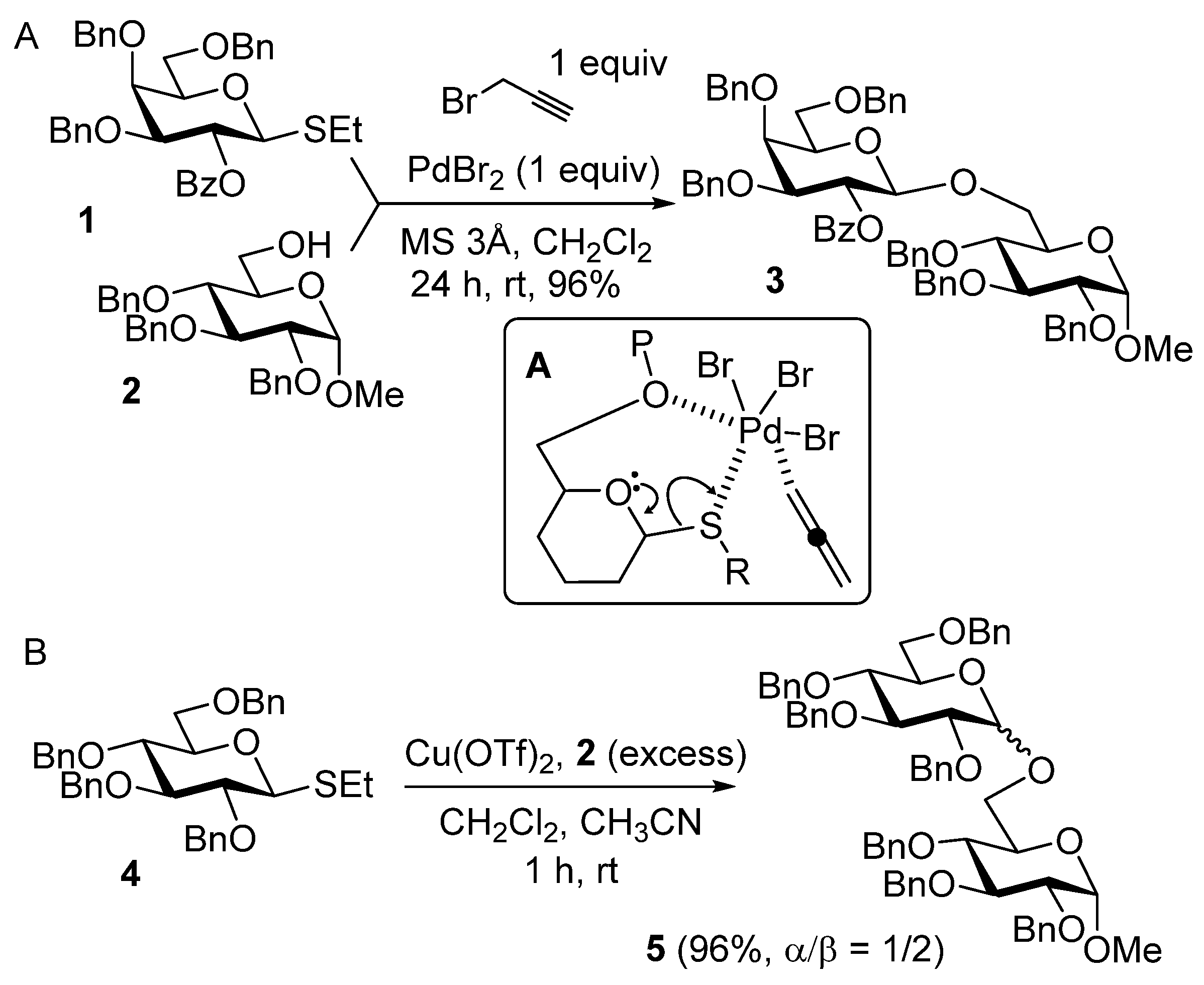
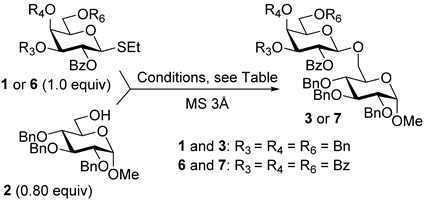 | |||
|---|---|---|---|
| Entry | Donor | Conditions | Product, Yield |
| 1 | 1 | CuBr2 (0.8 equiv), DCM, rt, 24 h | 3, 45% |
| 2 | 1 | CuBr2 (1.5 equiv), DCM, rt, 24 h | 3, 70% |
| 3 | 1 | CuBr2 (2.0 equiv), DCM, rt, 24 h | 3, 75% |
| 4 | 1 | CuBr2 (2.5 equiv), DCM, rt, 24 h | 3, 96% |
| 5 | 1 | CuBr2 (2.5 equiv), DCM, 40 °C, 4 h | 3, 84% |
| 6 | 1 | CuBr2 (2.5 equiv), DCE, rt, 22 h | 3, 98% |
| 7 | 1 | CuBr2 (2.5 equiv), DCE, 80 °C, 3 h | 3, 85% |
| 8 | 1 | CuBr2 (2.5 equiv), DCE/MeCN (1/1, v/v), rt, 6 h | 3, 70% |
| 9 | 1 | CuBr2 (2.5 equiv), MeCN, rt, 1.5 h | 3, 80% |
| 10 | 1 | Cu(OTf)2 (2.5 equiv), DCE, rt, 24 h | 3, 24% |
| 11 | 1 | CuCl2 (2.5 equiv), DCE, rt, 24 h | 3, 16% |
| 12 | 1 | CuBr (2.5 equiv), DCE, rt, 24 h | NR |
| 13 | 6 | CuBr2 (2.5 equiv), DCE, rt, 24 h | 7, 36% |
| 14 | 6 | CuBr2 (2.5 equiv), MeCN, rt, 6 h | 7, 50% |
| 15 | 6 | CuBr2 (2.5 equiv), DCE, 80 °C, 4 h | 7, 70% |
| 16 | 6 | CuBr2 (2.5 equiv), TfOH (0.5 equiv), DCE, rt, 24 h | 7, 96% |
| 17 | 1 | CuBr2 (2.5 equiv), TfOH (0.5 equiv), DCE, rt, 3 h | 3, 73% |
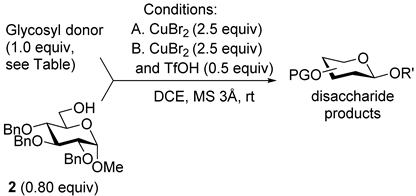 | |||
|---|---|---|---|
| Entry | Donor | Conditions | Product, Yield, Ratio α/β |
| 1 |  8 | A | 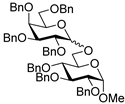 9, 72%, α/β = 1/1.5 |
| 2 |  10 | A | 9, 61%, α/β = 1/1.8 |
| 3 |  11 | A | 9, 45%, α/β = 1/1.5 |
| 4 |  12 | A or B | 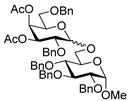 13, 35%, α/β = 6.5/1 or 54%, α/β = 6.5/1 |
| 5 |  4 | A |  14, 82%, α/β = 1.1/1 |
| 6 |  15 | A | 14, 79%, α/β = 1/1.4 |
| 7 |  16 | A | 14, 60%, α/β = 1/1.1 |
| 8 |  17 | A | 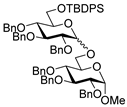 18, 73%, α/β = 2.0/1 |
| 9 |  19 | A |  20, 70%, β only |
| 10 |  21 | A or B |  22, 15%, α/β = 3.1/1 or 28%, α/β = 3.1/1 |
| 11 |  23 | A |  24, 76%, β only |
| 12 |  25 | A |  26, 60%, α/β = 1/1.1 |
 | ||
|---|---|---|
| Entry | Acceptor | Product, Yield |
| 1 |  27 |  28, 93% |
| 2 |  29 |  30, 95% |
| 3 |  31 |  32, 70% |
| 4 |  33 |  34, 95% |
Publisher’s Note: MDPI stays neutral with regard to jurisdictional claims in published maps and institutional affiliations. |
© 2022 by the authors. Licensee MDPI, Basel, Switzerland. This article is an open access article distributed under the terms and conditions of the Creative Commons Attribution (CC BY) license (https://creativecommons.org/licenses/by/4.0/).
Share and Cite
Pooladian, F.; Escopy, S.; Demchenko, A.V. Activation of Thioglycosides with Copper(II) Bromide. Molecules 2022, 27, 7354. https://doi.org/10.3390/molecules27217354
Pooladian F, Escopy S, Demchenko AV. Activation of Thioglycosides with Copper(II) Bromide. Molecules. 2022; 27(21):7354. https://doi.org/10.3390/molecules27217354
Chicago/Turabian StylePooladian, Faranak, Samira Escopy, and Alexei V. Demchenko. 2022. "Activation of Thioglycosides with Copper(II) Bromide" Molecules 27, no. 21: 7354. https://doi.org/10.3390/molecules27217354
APA StylePooladian, F., Escopy, S., & Demchenko, A. V. (2022). Activation of Thioglycosides with Copper(II) Bromide. Molecules, 27(21), 7354. https://doi.org/10.3390/molecules27217354







